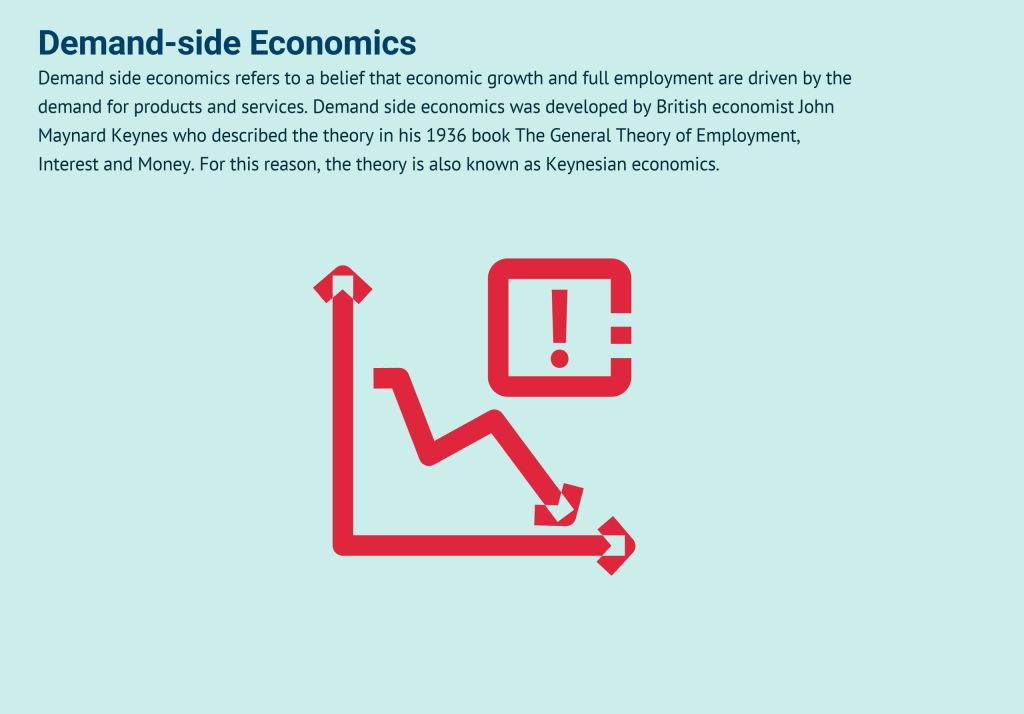Keynesian economists believe that the primary factor driving economic activity and short-term fluctuations are the demand for goods and services. The theory is sometimes called demand-side economics.
This perspective is at odds with classical economic theory, or supply-side economics, which states that the production of goods or services, or supply, is of primary importance in economic growth.

KEY TAKEAWAYS
- Demand-side economics is the theory that the demand for goods and services drives economic activity.
- A core characteristic of demand-side economics is aggregate demand.
- Governments can generate demand for goods and services if people and businesses cannot spend.
- Economist John Maynard Keynes developed his economic theories during the Great Depression of the 1930s.
- Keynes believed a government should increase spending to spur subsequent consumer and business expenditures in depressing economic activity.
Understanding Demand-Side Economics
Keynes maintained that unemployment is the result of inadequate demand for goods. During the Great Depression, factories sat idle. Due to a lack of product demand, factories had an insufficient need for workers.
This lack of aggregate demand contributed to unemployment, and contrary to classical theories of economics, the economy was unable to self-correct and restore balance.
One of the core characteristics of Keynesian economics or demand-side economics is the emphasis on aggregate demand. Aggregate demand comprises four elements: consumption of goods and services, investment by industry in capital goods, government spending on public goods and services, and net exports.
Under the demand-side model, Keynes advocated for government intervention to help overcome low aggregate demand in the short term, such as during a recession or depression. This could reduce unemployment and stimulate economic growth.
John Maynard Keynes
Economist John Maynard Keynes developed his economic theories partly to respond to the Great Depression of the 1930s. Before the Great Depression, classical economics was the dominant theory. It held that supply and demand market forces would naturally restore economic equilibrium over time.
However, Keynes believed that the Great Depression and widespread unemployment defied classical economic theories. His theories tried to explain why the free market mechanisms were not restoring financial balance.
Keynes’ book, The General Theory of Employment, Interest, and Money, was written in 1936 and reflected his experience as a witness to the Great Depression. In it, he rejects the belief that an economy in a downturn would right itself. Instead, he believed that action by the government was called for. It should intervene with increased spending and lower taxes to stimulate consumption.
Types of Demand-Side Economic Policies
Government Spending
If the other components of aggregate demand are static, government spending can help. The government can intervene if people are less able or willing to consume and businesses are less inclined to hire workers and invest in building more factories. It can increase government spending to generate demand for goods and services.
Keynesian economics supports heavy government spending during a national recession to encourage economic activity. Putting more money in the pockets of the middle and lower classes has a more significant benefit to the economy than saving or stockpiling cash in a wealthy person’s account.
Increasing the Money Supply
Central banks can also achieve this goal by altering interest rates or selling or buying government-issued bonds. This type of intervention is part of what is known as monetary policy. These actions, such as changing interest rates, can be used to increase the total money supply in the economy or the velocity of money flowing through the economy.
Increasing the flow of money correspondingly increases the velocity or the frequency at which $1 is used to buy domestically produced goods and services. Increased money speed means more people consume goods and services, thus increasing aggregate demand.
Example of Demand-Side Economic Policies
The financial crisis of 2008 sparked the U.S. government’s use of the demand-side economic policy. The Obama administration lowered interest rates. It also cut taxes for the middle class. It put together a $787 billion stimulus package. Moreover, the government intervened to overhaul the financial industry in a way not seen since the days of Franklin D. Roosevelt in the 1930s.
What Is Demand-Side Economics?
Demand-side economics is another name for Keynesian economic theory. It states that the demand for goods and services drives healthy economic activity.
How Are Supply-Side and Demand-Side Economics Different?
Demand-side economics holds that demand for goods and services drives economic growth. Supply-side economics (classical economic theory) states that producing goods and services drives economic growth. Demand refers to spending on goods. Supply refers to the production of goods.
Who Was John Maynard Keynes?
John Maynard Keynes was an English economist who became known for his macroeconomic theory of demand-side economics in the 1930s. It became known as Keynesian economics. He pushed for the policies of increased government spending and decreased taxes that he believed would stimulate demand for products and services during the Great Depression.





